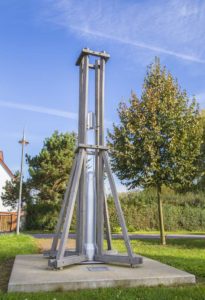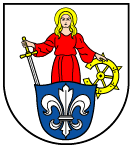
The “Magdeburg Pilot Rocket”, a liquid propellant rocket in preparation for the very first manned rocket flight, was launched on the Mose estate on June 29, 1933. The engineer
Rudolf Nebel
and his team from the rocket airfield Berlin -Reinickendorf were the initiators of the project. It was the birth of modern space travel .
Why is it called the “Magdeburg Pilot Rocket” and why did it launch in Mose in the first place?
The Lord Mayor of Magdeburg
Ernst Reuter
had lured the rocket pioneer Rudolf Nebel and his team to Magdeburg. The first rocket with a human on board was to be launched in Magdeburg as early as 1933.
Here are some excerpts from the Volksstimmen article of 31.12.1997 :
“Germany in the early 1930s. It was a time of rocket euphoria; in many laboratories, researchers were tinkering with flying objects that would explore the universe decades later. The engineer Rudolf Nebel, who has gone down in history as a pioneer of rocket research, was involved in this.
The Magdeburg city fathers, as private lecturer Matthias Tullner from Otto von Guericke University discovered, wanted to capitalize on the rocket euphoria of the time. The need for recognition of the city of Magdeburg and the chronic lack of money of the tinkerer and manager of the Berlin rocket airfield Rudolf Nebel came together. Nebel ultimately didn’t care, Tullner said, where the missile tests took place.
Nebel’s experiments continued at the Berlin airfield. When the first date of the rocket launch in March 1933 passed, the people of Magdeburg became impatient.
To reassure his backers, Nebel announced a test ascent of an unmanned rocket on the Mose estate near Wolmirstedt for May 20, 1933. New appointments followed, but they also failed.”
An excerpt in the book of Dr. Frank-E. Rietz `The Magdeburg Pilot Rocket `. 1933. On the path of manned spaceflight? (Mitteldeutscher Verlag), is the following explanation of the selection of the starting point of Moses:
“Of course, the municipality of Gübs, on whose territory Magdeburg Airport was located, also sensed a business opportunity. During the aforementioned inspection of the airfield on February 14, 1933, the municipal fathers stated that they intended to levy an amusement tax. Mengering as well as Nebel were against such a levy as it was not an amusement event and instead offered free tickets to the community of Gübs.
However, as can be seen from the letter from the community leader of Gübs to the Magdeburg airport company, the community did not want the 300 tickets offered, but instead wanted 4,500 Reichsmark for the community coffers. The village of Gübs received neither the 300 tickets nor the requested sum.The fame surrounding the Magdeburg pilot card would eventually be reaped by another estate: The Mose estate.
Alfred Druckenbrodt, a member of the district council, made the estate available. Druckenbrodt was also the owner of the estate at the same time. Away from the big city, the farmstead north of Wolmirstedt offered ideal conditions for a hazard-free rocket ascent.”
- Weight of the rocket: 200kg
- Height of the rocket: 6.5m
- Wooden launching tower height: 12m
- Fuel: Liquid oxygen, diluted alcohol, liquid nitrogen
- Flight: height 30m , width 60m
- historical significance: For the first time, a large rocket was launched with an engine that already implemented the principles of today’s modern rocket propulsion technology. The rocket engine can be described as the “grandmother” of the propulsion systems of later large rockets.



